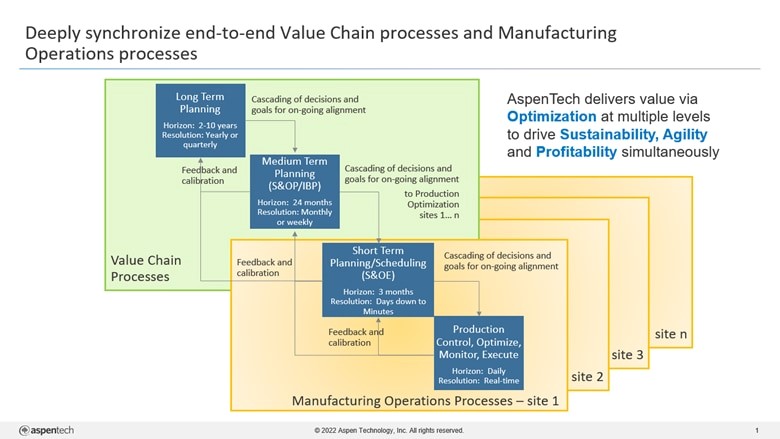The synchronization of key data, models, business processes and people are vital to ensure that operations execution team members stay aligned

As the world resettles into the post-pandemic new normal, it is an imperative for chemicals industries to unlock trapped value via digital transformation. This approach mandates the synchronization of value chain and manufacturing operations processes. A set of activities that accomplish a specific organizational goal, business processes are everywhere throughout organizations. In this article, four key business processes present in chemicals companies and their purposes will be highlighted. There are also examples of chemicals companies that have unlocked business value within and across these processes, as part of digital transformation initiatives.
Organizations should pay attention to business processes because they determine how well they can move toward achieving its sustainability, agility and profitability goals. The better a company’s processes, the more effective the business. More importantly, an organization’s business processes can become a competitive advantage for chemicals’ producers, especially if you deeply synchronize key value chain processes with manufacturing operations processes. This is critically important in the context of digital transformation initiatives.

Figure 1: Framework illustrating the four key business processes (blue boxes) spanning value chain and manufacturing operations
The purpose of long-term planning processes
Every manufacturing company, no matter its size, does some form of long-term planning. The planning at this level typically looks two to ten years into the future. Long-term planning is often closely related to capital budgeting activities, a process by which a company determines the value of potential investment projects and involves analyzing potential investment projects to understand their projected operational and financial benefits. Examples of such long-term planning studies include Capital and/or Operational Expenditure (CAPEX/OPEX) economic investments studies, sustainability and emissions reduction studies, manufacturing footprint studies, etc.
A recent customer case study, global energy and chemical company, Repsol S.A. uses control tower solution to manage its integrated business value chain. Based in Madrid, Spain, the company operates three integrated petrochemical complexes, managed as a single hub. Repsol was looking for an end-to-end supply chain control tower that would provide economic and customer service tradeoffs for planning across the entire chemicals value chain. Post-implementation, the company stated that the solution enables support for strategic studies, such as the ability to analyze decisions to buy, sell or build production lines, depots and other assets. In general, companies tend to value mathematical optimization capabilities, which is typically set to maximize profits, across the end-to-end value chain, over the planning time horizon.
From a sustainability standpoint, a chemicals producer has started using their Aspen Supply Chain Planning (SCP) software solution to make progress in addressing the dual challenge – considering profitability and sustainability goals holistically. This customer incorporated Scopes 1, 2 and 3 related emissions data into the solution. For Scopes 1 and 2 emissions data, the customer gathered this from internal systems. For Scope 3, the customer worked with their suppliers and logistics providers to come up with the data and emissions factors. The company is now using the solution to evaluate potential CAPEX/OPEX investment projects related to sustainability to plot an efficient path to achieving their near and long-term net zero goals. For example, they analyzed a proposed CAPEX investment related to a potential solar electricity project at a manufacturing site, its impact on their enterprise-wide profit and loss (P&L), as well as projected reduced emissions forecasts over a ten-year planning horizon.
The purpose of medium-term planning processes
Many companies have a name for this process – Sales and Operations Planning (S&OP) or Integrated Business Planning (IBP). The planning done at this level, typically looks 24 months into the future across the entire supply chain and provides value by ensuring that the company is working towards its strategic Profit and Loss (P&L) goals – balancing end-to-end supply and demand, as well as maximizing profitability.
The purpose of short-term planning and scheduling processes
Short-term planning is as ubiquitous to companies as both medium and long-term planning. This is, however, typically a daily process and is often referred to as Sales and Operations Execution (S&OE), which typically looks up to three months into the future at a high level of resolution. An S&OE process provides value by enabling supply chain and manufacturing operations team members to respond and manage the inevitable daily supply and demand disruptions that occur. A customer, Bakelite Synthetics shared that with Aspen Plant Scheduler software solution, their organization can see 90 days into the future. This essentially means that the company can see inventory, capacity utilization and demand developments and trends at the required level of accuracy and granularity.
In consideration of sustainability, a European specialty chemicals customer has a regulatory requirement on Sulphur Dioxide (SO2) emission limits. In partnering with AspenTech, the company can calculate and track instantaneous SO2 output, which can then be used to observe the scheduled production against the limit. With alerts, their schedulers can adjust the production schedule to reposition certain products to smooth the emissions and stay within the regulatory limits.
The purpose of production optimization, monitoring, and execution processes
The synchronization of key data, models, business processes and people are vital to ensure that operations execution team members stay aligned. This starts with realistic daily or weekly production goals, derived from the short-term planning and scheduling process. Many companies, such as Shell Catalysts and Hexion, now enable daily alignment across their supply chain and manufacturing operations teams via a digital manufacturing collaborative hub.
Digital transformation: deep synchronization and alignment across processes unlocks trapped value
The overarching goal is to ensure that all these processes remain aligned, so that decisions being made in the higher-level planning processes can cascade down toward day-to-day execution. It is equally important that all the enabling supply chain and manufacturing operations digital solutions used in these business processes remain appropriately synchronized. Deep synchronization across value chain and manufacturing operation processes is a critical element to enable chemicals companies to digitally transform and reach new levels of customer centricity, sustainability, agility, and profitability.
Register Now to Attend NextGen Chemicals & Petrochemicals Summit 2024, 11-12 July 2024, Mumbai

Subscribe To Our Newsletter & Stay Updated